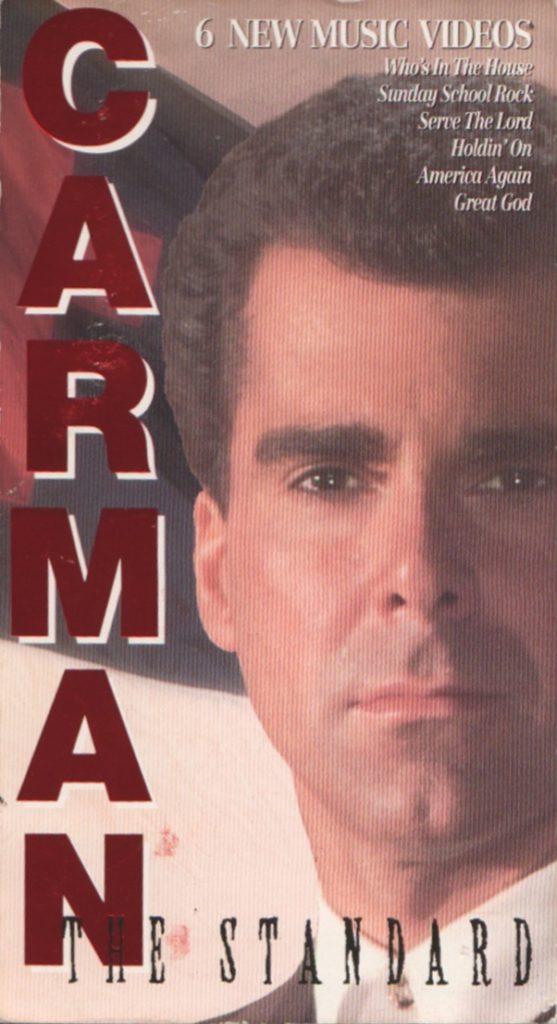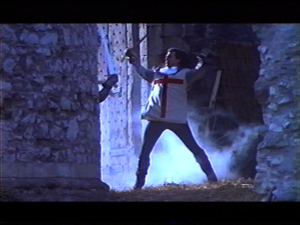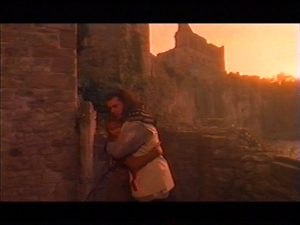By Don Jolly
VHS tapes are an alienated, and alienating, technology. They have the aesthetic of a Phililp K. Dick creation from the early seventies: dour, blue-black petrochemical rectangles with two ghost-white “eyes” in the rear of their casings, “played” by being fed into clacking machines whose guts (temporarily exposed in the act of loading) bristle with odd spindles and chrome. They are occult objects, a media that keeps its secrets.
I found “The Standard” last Christmas, in a Goodwill in Texas. Since that time I’ve done a lot of research. I now know, for instance, that Carman Licciardello, the artist behind the tape, was a major player in Christian Contemporary Music, or C.C.M. circles during the nineteen eighties and nineties. I know he was twice named artist of the year within that genre by Billboard magazine. I know, thanks to his website [http://www.carman.org/home.php] that his show at Dallas’ Texas stadium show packed in more bodies than appearances by Paul McCartney, Pink Floyd, and U2 at the same venue. I know that a marketer for the Carman camp, Chris Estes, when speaking to the Huffington Post last year, described the artist as “the Michael Jackson of Christian music in the 1980s,” at least in terms of scope and theatricality. I know, too, that on February 14th, 2013, Licciardello was diagnosed with terminal cancer of the blood and bone marrow. He went to Kickstarter, raising money for an expansive nation-wide tour. Thanks to a series of disarmingly personal “Countdown Diaries” [http://www.youtube.com/channel/UC4AeBuDK4tJTh0PrQidiQHQ?feature=watch] released through Carman’s Youtube channel, I know some portion of his subsequent struggles with money, music and personal faith.
I know, also, that every ex-evangelical I’ve spoken Carman’s name to in the run-up to this column has been overpowered, sometimes for as long as half an hour, by a kind of intense, embarrassed nostalgia. Many of them didn’t even experience his music directly — one former Baptist used to suffer through preaching against the artist. Even so, Carman held a deep and difficult to identify significance for him. The question I’ve been asking since I first fed “The Standard” into the clunking toad/slide-projector of my VCR is what, precisely, that significance is.
“The Standard” tape is representative Carman. Released in 1994, it features music videos drawn from his album of the same name, issued the previous year. These songs share nothing in terms of either genre or style — there’s bombastic hip-hop, celebratory pop-country and even earnest political soliloquizing over yankee-doodle flute and percussion. What they do share is Carman himself, who commands the central space of each video with an easy, if somewhat affected, charisma. They also share a broadly Christian message with an occasional edge of right-wing activism.
The difficulty in addressing “The Standard,” however, is that summarizing its parts as an aesthetic or ideological wholes is deceptive. They’re music videos, and each of the six has some kind of internal consistency, but like many pop videos from the early nineties that consistency is sidelined in the favor of constant, jarring cuts from image to image. The eye never rests on one subject long enough to understand it fully. When the eight minute medieval epic that closes the tape, “Great God,” concludes, viewers are left sifting through a subliminal payload of fashions, dance moves, special effects and shouted theology. It’s a synecdochic work, where quick cuts and individual lyrics overpower the whole, muting “The Standard’s” religious content.
Take the video that opens the tape, “Who’s in the House?” Carman bounces through this one as an early-nineties rapper, dancing and strutting across a stage in a harmlessly dilapidated warehouse, answering the title’s question with repeated chants of “J.C.!” While Jesus is a preoccupation of the lyrics, the driving cuts focus on Carman alone: Carman in his purple shorts, Carman being leapfrogged by an enthusiastic dancer, Carman bumping fists with a nearly-unseen black man, scowling smugly, in a bizarre simulacrum of street cred. Visually it is Carman himself, rather than his faith, that is at the center of the piece. This makes “who’s in da house?” into a strangely ambiguous question.
This ambiguity continues in the tape’s second song, “Sunday School Rock,” a black and white tribute to 1950s teen-music showcases. Here Carman, as “Major C,” commands the frame with an incongruous tough-guy persona, running through Sunday school lessons in basic Christian practice. “To fear the Lord is wisdom,” he sings, “to serve the lord divine — but to really break it down just repeat these words of mine.” A dance party breaks out, of course, complete with screaming teenage girls —shades of the Beatles on Ed Sullivan. Carman’s persona, and the theological content of the lyrics, end up giving the video a similar arc to Nirvana’s kinescope video for “In Bloom,” [http://www.youtube.com/watch?v=PbgKEjNBHqM&feature=kp] where the 1950s aesthetic is contrasted both lovingly and ironically by the ideology of the performance. Given the contemporaneous releases of the two (“In Bloom’s” video was released two years earlier in 1992) I think the case for direct influence is strong.
Which highlights the cross-pressures at play in “The Standard.” Each of Carman’s videos are technically sophisticated mimics of American pop music, to the point where calling them “mimicry” seems inaccurate. The best comparison I can think of is the parodist Weird Al Yankovic, whose videos often replicate, exactly, the forms and conventions of the songs they’re meant to spoof, with the simple substitution of subject matter for humorous effect. Yankovic, in his “Smells Like Nirvana,” takes the aesthetic beats of the band’s “Smells Like Teen Spirit” and turns them into a paean to lyrical unintelligibility. Carman, in “Sunday School Rock,” does the same, using the aesthetic hits of his 1950s source material as a vehicle for communicating love and devotion to the personal salvation of Christ. The problem is that these adopted aesthetics make Carman, as the charismatic musician, into the focal point of the video, blunting its salvific message.
To a degree, this personal focus makes sense. Carman’s early success as a Christian musician occurred in Tulsa Oklahoma in the early 1980s, where he was part of the circle surrounding the Pentecostal minister and singer Carlton Pearson. In this context, as in evangelicalism as a whole, a charismatic approach to ministry would have been natural. The question Carman poses, through “the Standard,” is to what degree such charismatic ministry is compatible with the aesthetics of pop.
This tension is especially visible in the tape’s finale, “Great God.” The video’s narrative begins with a soft-focus close up of a young, heavily made-up high-school blonde. A hand snaps in front of her face, waking her from a daydream. We pull back, finding her in class. Her teacher, played by Carman, wants to know what she has learned about the “dark ages.”
“As the Grand Inquisitor would say ‘come lassie, tell us, what is your doctrine?” he intones, adopting a Scottish accent. The girl shakes her head, admitting ignorance, which prompts Carman to give a last-minute lecture about the infiltration of the medieval Catholic Church by “evil spiritual forces,” in preparation for “the big test.” During this speech, the girl drifts off into another daydream. At this point the video switches gears, becoming a fantasy of castles and wicked Catholics. The girl finds herself chained to a dungeon wall and dragged before an inquisitor. Carman reappears as a muscular, attractive ur-protestant, defeating a crowd of evil bishops with a Bible that, in an embarrassing special effect, transmutes into a sword. At the story’s end, the “evil spiritual forces” vanquished, Carman embraces the girl against a romantic backdrop of fiery skies and smashed castles. Back in the classroom, the girl enthusiastically finishes her test. A blade of straw, carried from the dungeon, falls from her hair. It was all a dream — or was it?
While “Great God” contains intriguing nubs of religious and historical arguments about the relationship between Catholicism, the Reformation and theodicy, its overpowering visual topic is, again, Carman. Carman dominates the classroom framing device as a wise, well-liked and charismatic teacher. He distinguishes himself in the fantasy as a cinematic sword-fighter, a grimy masculine ideal and, most uncomfortably, as a romantic interest for a girl half his age. None of this is to suggest ego on Carman’s part — rather, each of these elements is clearly drawn from “Great God’s” larger cultural milieu.
If we start by considering Michael Jackson as “the secular Carman,” we see an extremely prominent theme, within his video output, of singular, sharply dressed crusaders intervening against mobs. “Great God,” is, essentially, a riff on work such as Jackon’s “Smooth Criminal,” albeit with a sense of style more Lady Hawke than Maltese Falcon and, once again, religious content largely substituted for the romantic. Like “Smooth Criminal” or “Bad,” Carman’s “Great God” is an absorbing, cinematically realized video with a clear, if simple, narrative arc focused on a supernaturally cool protagonist. What’s different between the two is that one exists in a “buffered,” or “secular” space — a visual world where Jackson is allowed to be the ultimate example of “bad” because there is no diegetic evidence to argue the point. Carman, by opening his videos to God, and focusing their lyrical content on directing one’s devotional energies beyond the self, makes his personal dominance of the visuals difficult to parse. It’s Carman, not God, who turns the Bible into a sword. It’s Carman who gets the girl. It’s Carman, at the end of the daydream, who controls the classroom. It’s an uncanny effect, and it’s tempting to read it as cynical. A similar problem occurs in Carman’s rhyming patriotic hymn, “America Again,” where right-wing talking points about prayer in school are intercut with footage of gay pride parades, African Americans sitting on street corners and protesters getting pummeled by police. These videos seem to indicate a reality beyond themselves without acceding Carman’s command of the visuals. My Baptist friend, the one whose preacher spoke out against Carman, detected many of these same problems. The dancing in “Sunday School Rock” was “too worldly,” he said, as was the “downbeat” construction of just about every song. Only the milquetoast piano ballad “Serve the Lord” passed muster for my friend as something that would have had a place in the church of his younger days. Carman’s approach to C.C.M., using immaculate pop aesthetics to convey religious themes, only works if one assumes that these aesthetics do not compete or contradict in any way with the intended message.
This tension may be heightened by the video format. Carman’s live events, half expansive stage show and half tent revival, are defined by the moment where the performance stops and the audience streams to a “counseling center,” ready to be saved. According to his website, sometimes as many as 5,000 a night are moved in this way. For these young Christians, Carman’s aesthetic poses no problem. In fact, it offers a solution — directing them towards a singular religious experience, and a stronger identification with Christ, all through the precise deployment of pop theatricality. As I said, this is a significance that I find opaque. My experience of pop is different — more compartmentalized, more disposable, more grossly material. Carman approaches the same subject with different eyes.
VHS tapes are occult objects. They were expensive to produce, light on background materials and, with the exception of movies designed for the rental market, they have a tendency to present themselves matter-of-factly, with the implicit understanding that anyone considering a purchase will know what they are purchasing. “The Standard,” doesn’t explain itself — it just gives us Carman, and lets the audience decide what comes next.
For my part, I find that “The Standard” has left me with more questions than answers. I want to know where Carman places the line between “religious” and “secular.” I want to know how this division is operative in the lives of his fans. Most of all, I want to understand the complicated significance he seems to hold for those who have encountered him.
Luckily, this isn’t his only VHS.
Next month: “You’re breaking God’s heart, and a condom isn’t going to fix that.”
Don Jolly is a Texan visual artist, writer, and academic. He is currently pursuing his master’s degree in religion at NYU, with a focus on esotericism, fringe movements, and the occult. His comic strip, The Weird Observer, runs weekly in the Ampersand Review. He is also a staff writer for Obscure Sound, where he reviews pop records. Don lives alone with the Great Fear, in New York City.
Jolly will be presenting at The Observatory on February 21st on one of his primary research interests, the Church of Scientology. More information on his “illustrated lecture” can be found here. Doors at eight, admission eight dollars.








